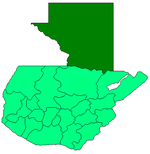El Petén
El Petén | |
Capital | Flores |
População | 366 735 habitantes |
Censo | 2002 |
Área | 35 854 km² |
Densidade | 10,23 hab/km² |
Mapa | |
 | |
El Petén é um dos 22 departamentos da Guatemala, país da América Central. Sua capital é a cidade de Flores.
História |
Em 2018, foram descobertas ruínas da civilização maia na região de El Petén.[1]
Municípios |
- Dolores
- Flores
- La Libertad
- Melchor de Mencos
- Poptún
- San Andrés
- San Benito
- San Francisco
- San José
- San Luis
- Santa Ana
- Sayaxché
Referências
↑ 'Megalópole' maia em plena selva é descoberta com nova tecnologia a laser BOL - site de notícias